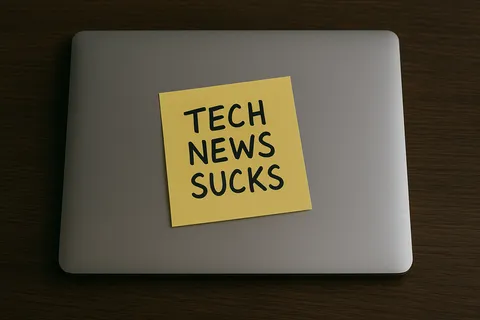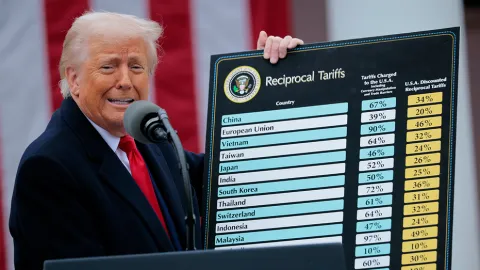So, remember when we said we weren’t going to do another story on the tariffs unless something big happened?
Yeah… this counts.
After just days of market chaos and widespread backlash, the U.S. has paused its sweeping “reciprocal” tariffs for 90 days, easing the pressure on most trade partners — and sending the markets into full-blown relief mode.
The S&P 500 shot up 9.5% in a single day — its biggest jump since the 2008 financial crisis. The Dow rose 7.8%, and the Nasdaq jumped 12.1%. Wall Street responded like someone had thrown them a life jacket mid-storm.
But before we all start celebrating like it’s 1999: this isn’t over, especially not for the tech industry.
What Actually Changed (and What Didn’t)
Here’s the latest:
- The 10% universal tariff on all imports? Paused for 90 days.
- The tougher “reciprocal” tariffs, which matched each country’s import taxes on U.S. goods? Also paused — except for China.
- China’s new tariff rate: now at 125%, after both sides doubled down on the trade conflict.
- Countries like Canada and Mexico remain exempt under existing trade agreements.
- The White House framed the move as strategic flexibility — though most analysts saw it as a direct response to financial market turbulence.
From where we sit, the pause seems less about long-term planning and more about pressing pause on a situation that was heating up fast. It may have calmed markets for now, but the core trade tensions — especially with China — haven’t gone anywhere.
Why Tech Isn’t Out of the Woods Yet
The markets are breathing a little easier. But in the tech world, things are still pretty tangled.
1. China’s Still in the Hot Seat
The biggest concern for anyone working in hardware, semiconductors, or large-scale infrastructure is still very much in play. With a 125% tariff on Chinese imports, any products, components, or raw materials coming from China just got significantly more expensive — and that affects everything from consumer electronics to industrial gear.
For many companies, sourcing outside of China isn’t a quick fix. Rebuilding those supply lines takes time, money, and sometimes a total redesign of how and where things get built. It’s one thing to announce a tariff, but the knock-on effects ripple for months (if not longer).
2. A Major Tech Launch Already in Trouble
One of the most high-profile tech releases of the year — the Nintendo Switch 2 — has already hit turbulence.
Preorders were quietly delayed last week, and supply chain sources pointed directly at the original round of tariffs. Nintendo, like many consumer electronics companies, relies heavily on Chinese and Southeast Asian manufacturing. With the tariffs in flux, production timelines have gotten fuzzy, and it’s unclear whether the release window will shift again.
Now that tariffs are on pause, the question is: Will the Switch 2 launch get “un-paused” too?
Only time — and shipping manifests — will tell.
3. Uncertainty is Still the Headache
Even with the pause, the bigger challenge right now is the lack of predictability. If you’re managing hardware, planning a product launch, or just trying to budget for your next wave of gear — you’re flying through fog.
Will the tariffs return in 90 days? Will new ones pop up in different sectors? Are certain vendors going to pivot? These aren’t theoretical questions — they’re real pain points for teams making daily calls about inventory and manufacturing.
4. Inflation vs. Growth — Not a Great Trade-Off
Economists are already saying the higher tariff on China could cancel out much of the inflation relief from the paused global rates. And if supply chains stay tangled or get even tighter, we could see tech prices climb anyway — even without full tariffs in place.
For example, GPUs, SSDs, and advanced processors all rely on either materials or fabrication that touches China. There’s no magic workaround, and even the rumor of new restrictions or costs tends to cause vendors to raise prices preemptively.
Trevor Score: 5/10 — A sigh of relief, not a solution
This isn’t a formal review — it’s just how I felt watching this policy hurricane from the trenches. A gut-check from someone actually navigating the real-world fallout.
There’s temporary relief here, but the fundamentals haven’t changed. For tech, especially companies tied to physical goods or global logistics, it’s hard to plan, hard to budget, and harder than ever to build with confidence.
We’re not in panic mode — but we’re definitely not back to normal either.
Final Verdict: A 90-Day Timeout, but Tech’s Still Watching the Clock
If you’re in tech, you know how much this stuff matters under the surface. Even a temporary tariff policy can scramble your build schedule or change the price of your BOM (bill of materials) overnight.
Right now, it feels like the industry is being asked to wait and see — again. Maybe some companies get lucky. But most of us are still prepping for price swings, availability issues, or worst-case sourcing delays.
This isn’t about politics for us. It’s about workflow, production, and keeping projects on track. And while Wall Street might be celebrating, tech teams are still in “hold pattern” mode.
The Pause Button Was Hit — Now What?
That’s two tariff updates from us in as many weeks. Hopefully that’s the last for a while. But if this rollercoaster keeps climbing, dipping, and doubling back, we’ll be right here — seatbelt fastened, parts list in hand, and still waiting for that Switch 2 preorder to go live.





